|
|
|
Sort Order |
|
|
|
Items / Page
|
|
|
|
|
|
|
| Srl | Item |
| 1 |
ID:
183409
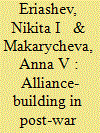

|
|
|
|
|
| Summary/Abstract |
Although great powers may forge ad hoc coalitions to attain their short-
term goals, this does not diminish the role of long-term strategic alliances.
The alliance theory has long become a separate strand of IR. However,
most scholars have focused more on external rather than internal threats
to account for alliance choices. The authors review the existing literature
on the formation of alliances and, shifting the focus to the struggle for
power between internal political actors, propose a theory that explains the formation of asymmetric alliances. By extending support to friendly
political groups, great powers can build alliances with those countries
where the elites are facing formidable opponents. On the contrary, leaders
who rule unchallenged have little incentive to rely on external patrons.
The article examines the cases of postwar Italy and Yugoslavia to test
the proposed hypotheses. The conclusions drawn from the analysis help
formulate recommendations that can be used by Russia in its current
strategic environment.
|
|
|
|
|
|
|
|
|
|
|
|
|
|
|
|
| 2 |
ID:
181952
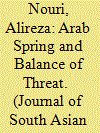

|
|
|
| 3 |
ID:
117948
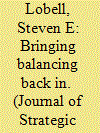

|
|
|
|
|
| Publication |
2012.
|
| Summary/Abstract |
This article challenges the conventional wisdom that Neville Chamberlain rejected the British tradition of balance of power in the 1930s. In contrast to balance of power and balance of threat theories, states do not balance against aggregate or net shifts in power. Instead, leaders define threats based on particular elements of a foreign state's power. The import is that different components of power of a foreign state are more or less threatening and aggregate shifts in power alone may not provoke counterbalancing behavior. In the 1930s, Britain balanced against the most threatening components of power: the German Luftwaffe and the threat of a knock-out air assault against the homeland, Japan's Imperial Navy and its threat to Britain's commercial trade routes and the Dominions in East Asia, and the Italian Navy and the threat to Britain's line of communication through the Mediterranean Sea to India and Asia. Given Britain's difficult financial circumstances, all other components of power, such as the army and the land components of power of Germany, Japan, and Italy were ranked as secondary in terms of its rearmament priorities. Thus, London was able to narrow the gap with Berlin in specific components of power of strategic importance such as aircraft production or to exceed Germany in other areas such as the Royal Navy and its battlefleet.
|
|
|
|
|
|
|
|
|
|
|
|
|
|
|
|
| 4 |
ID:
069881
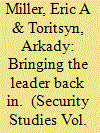

|
|
|
|
|
| Publication |
2005.
|
| Summary/Abstract |
Traditional alignment theories, such as balance-of-power and balance-of-threat theories, suggest that states confronted by more powerful or threatening states are more likely to balance against those states than to bandwagon with them. Yet in the context of the newly independent states of the Commonwealth of Independent States (cis), this proposition has not held true. A refinement of Steven David's theory of omnibalancing sheds light on this empirical puzzle. Using in-depth case studies of Ukraine and Uzbekistan, the authors argue that the alignment calculations of cis leaders have been driven more by internal threats to those leaders' political survival than by external threats to the state. These internal threats include the more traditional variants, such as assassination attempts, coups, and civil war, but also include opposition leaders and parties that may be perceived as challenging a leader's political survival. The post-September 11 security environment and the u.s.-led war on terrorism has also fundamentally changed the strategic calculations of cis leaders, as the United States is now willing to assist leaders against Islamist extremism and terrorism, taking over a role formerly played by Russia. The theoretical nuances offered here provide a more robust and accurate understanding of alignment motivations in the cis, especially in light of recent revolutions in Georgia, Ukraine, and Kyrgyzstan.
|
|
|
|
|
|
|
|
|
|
|
|
|
|
|
|
| 5 |
ID:
137167
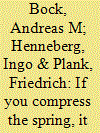

|
|
|
|
|
| Summary/Abstract |
The narrative of an aggressive and neo-imperialist Russia that has dominated analyses of the 2014 Ukrainian crisis lacks theoretical rigour. We argue that a sustainable transformation of the Ukrainian crisis requires an accurate analysis of the context of the conflict, which should include an understanding of Moscow’s perception of the threats to its interests. This policy brief develops a theoretical understanding of the Ukrainian crisis through the lens of Stephen M. Walt’s balance of threat theory. We conclude that a realist analysis will help to explain Russian actions.
|
|
|
|
|
|
|
|
|
|
|
|
|
|
|
|
| 6 |
ID:
113806
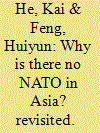

|
|
|
|
|
| Publication |
2012.
|
| Summary/Abstract |
Why did the US prefer multilateral alliances in Europe, but bilateral alliances in Asia after World War II? Rationalists and constructivists debate the impact of power, institutions, and identities in explaining this highly contested question. We introduce a new argument embedded in prospect theory from political psychology - a prospect-threat alliance model - to account for the variation in US alliance strategy toward Europe and Asia after World War II. Through setting the threat level as a reference point for leaders' prospects of gains or losses, we suggest: (1) high threats frame decision-makers in a domain of losses, and multilateral alliances become a favorable alliance choice because states are more likely to take the risk of constraining their freedom of action in return for more help from multiple allies as well as for avoiding further strategic losses; (2) low threats position leaders in a domain of gains, and bilateral alliances win out because states are risk-averse in terms of maintaining their freedom of action in seeking security through alliances with fewer allies. US alliance policy toward Asia after World War II is a within-case analysis that tests the validity of the prospect-threat alliance model.
|
|
|
|
|
|
|
|
|
|
|
|
|
|
|
|
| 7 |
ID:
192845
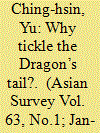

|
|
|
|
|
| Summary/Abstract |
The security situatsssion across the Taiwan Strait has recently deteriorated rapidly. Scholars and policymakers have attributed this development to the concurrence of an increasingly assertive Communist Party in China, a unilateralist Trump administration in the US, and a new DPP government in Taiwan since 2016. For the Taiwanese, the security concern is on their doorstep, but their attitudes are under-studied. I find that judgments of China’s animosity to Taiwan, China’s importance for Taiwan’s economy, (dis)agreement with the “one country, two systems” formula, concern regarding developments in Hong Kong, (dis)agreement with alliance with Japan and the US, (dis)belief in the US’s security commitment to Taiwan, and perception of the comparative strength of China versus the US are closely associated with respondents’ choice to ally with China or the US. These findings also shed light on Taiwanese (over)optimism regarding the US’s role in the wake of Chinese invasion of Taiwan.
|
|
|
|
|
|
|
|
|
|
|
|
|
|
|
|
|
|
|
|
|